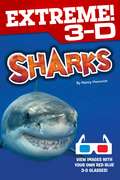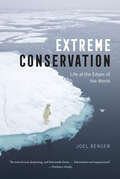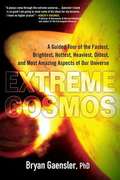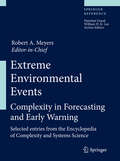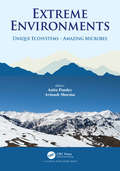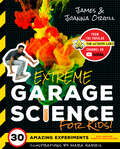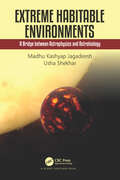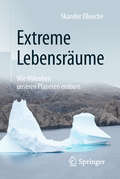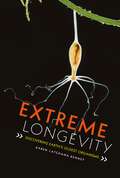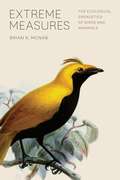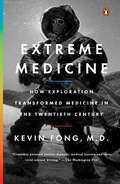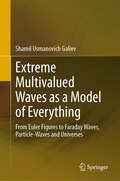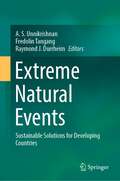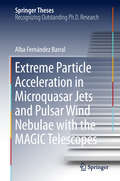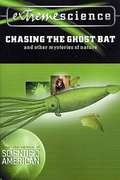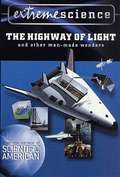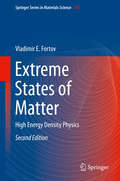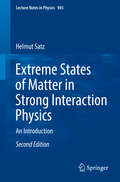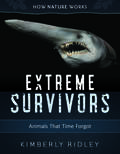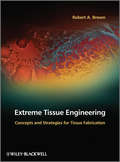- Table View
- List View
Extreme 3-D: Sharks
by Nancy HonovichGo face-to-face with the world's most awesome predators! Extreme 3-D: Sharks is packed with incredible 3-D photos of the most fasincating creatures in the sea!
Extreme Animals: The Toughest Creatures on Earth (Animal Science)
by Nicola DaviesFrom the persevering emperor penguins of the South Pole to the brave bacteria inside bubbling volcanoes, from the hardy reptiles of the driest deserts to the squash-proof creatures of the deepest seabeds, animals have adapted to survive in conditions that would kill a human faster than you can say "coffin." Discover how they do it in this amazing natural history book from a celebrated team -- and find out who wins the title of the toughest animal of them all. Back matter includes an index and a glossary.
Extreme Biomimetics
by Hermann EhrlichThis book discusses the current direction of the research approach to extreme biomimetics through biological materials-inspired chemistry and its applications in modern technology and medicine. It is a resource covering topics of extreme (psychrophilic and thermopilic) biomineralization, solvothermal and hydrothermal chemistry of metal oxides and nanostructured composites, and bioinspired materials science in a diverse areas. The authors review the current advances in the extreme biomimetics research field and describe various approaches introduced and explored by their respective laboratories. * Details the basic principles of extreme biomimetics approach for design of new materials and applications; * Includes numerous examples of the hierarchical organization of hydrothermally or psychrophilically obtained biocomposites, structural bioscaffolds, biosculpturing, biomimetism, and bioinspiration as tools for the design of innovative materials; * Describes and details the principles of extreme biomimetics with respect to metallization of chemically and thermally stable biopolymers.
Extreme Conservation: Life at the Edges of the World
by Joel Berger"Extraordinary. . . . Berger is a hero of biology who deserves the highest honors that science can bestow."—Tim Flannery, New York Review of Books On the Tibetan Plateau, there are wild yaks with blood cells thinner than those of horses’ by half, enabling the endangered yaks to survive at 40 below zero and in the lowest oxygen levels of the mountaintops. But climate change is causing the snow patterns here to shift, and with the snows, the entire ecosystem. Food and water are vaporizing in this warming environment, and these beasts of ice and thin air are extraordinarily ill-equipped for the change. A journey into some of the most forbidding landscapes on earth, Joel Berger’s Extreme Conservation is an eye-opening, steely look at what it takes for animals like these to live at the edges of existence. But more than this, it is a revealing exploration of how climate change and people are affecting even the most far-flung niches of our planet. Berger’s quest to understand these creatures’ struggles takes him to some of the most remote corners and peaks of the globe: across Arctic tundra and the frozen Chukchi Sea to study muskoxen, into the Bhutanese Himalayas to follow the rarely sighted takin, and through the Gobi Desert to track the proboscis-swinging saiga. Known as much for his rigorous, scientific methods of developing solutions to conservation challenges as for his penchant for donning moose and polar bear costumes to understand the mindsets of his subjects more closely, Berger is a guide par excellence. He is a scientist and storyteller who has made his life working with desert nomads, in zones that typically require Sherpas and oxygen canisters. Recounting animals as charismatic as their landscapes are extreme, Berger’s unforgettable tale carries us with humor and expertise to the ends of the earth and back. But as his adventures show, the more adapted a species has become to its particular ecological niche, the more devastating climate change can be. Life at the extremes is more challenging than ever, and the need for action, for solutions, has never been greater.
Extreme Cosmos: A Guided Tour of the Fastest, Brightest, Hottest, Heaviest, Oldest, and Most Amazing Aspects of Our Universe
by Bryan GaenslerA star-gazer since childhood, astronomer Gaensler has not lost his wide-eyed fascination with the stars. In this engaging, accessible, and eye-opening read, he gives readers a guided tour of the universe, with an emphasis on the extremes of temperature, light, and more.
Extreme Environmental Events: Complexity in Forecasting and Early Warning
by Robert A. MeyersExtreme Environmental Events is an authoritative single source for understanding and applying the basic tenets of complexity and systems theory, as well as the tools and measures for analyzing complex systems, to the prediction, monitoring, and evaluation of major natural phenomena affecting life on earth. These phenomena are often highly destructive, and include earthquakes, tsunamis, volcanoes, climate change,, and weather. Early warning, damage, and the immediate response of human populations to these phenomena are also covered from the point of view of complexity and nonlinear systems. In 61 authoritative, state-of-the art articles, world experts in each field apply such tools and concepts as fractals, cellular automata, solitons game theory, network theory, and statistical physics to an understanding of these complex geophysical phenomena.
Extreme Environments: Unique Ecosystems – Amazing Microbes
by Anita Pandey; Avinash SharmaThe book Extreme Environments: Unique Ecosystems – Amazing Microbes is an attempt to showcase the uniqueness of extremophiles, the largely unexplored group that has the abilities to function in hostile conditions and represent the very ancient life forms that thrived on earth billions of years ago. The book covers a wide range of research achievements in the field of microbiology of extreme environments right from the conventional approaches of cultivation to recently evolved high throughput sequencing technologies. The book provides a broad spectrum of information about the taxonomy, physiology, ecology and biotechnological applications of extremophiles from various extreme environments across the globe.
Extreme Garage Science for Kids!
by James Orgill Joanna OrgillFor years, James Orgill has amazed millions of YouTube fans with zany experiments in his popular videos on The Action Lab channel. Now, for the first time, you can do these experiments at home! Extreme Garage Science for Kids! is jam-packed with killer projects and irresistibly nerdy explanations of how the world works. Draw on water. Remove the iron from your Cheerios. Defy Newtonian physics! Bursting with fun illustrations and full-color, photographed step-by-step instructions, Extreme Garage Science for Kids! is a thrilling scientific adventure for young minds everywhere!
Extreme Habitable Environments: A Bridge between Astrophysics and Astrobiology
by Madhu Kashyap Jagadeesh Usha ShekharExtreme Habitable Environments is a book authored with the intention of providing introductory material suitable for those interested in learning about exoplanets. The focal point of this book is to expose its readers to the excitement in identifying exoplanets and exploring the possibility of life on them. This book offers structured content enriched with graphics, flow charts, images and worked examples that make reading and learning a delight. This book further serves as a hands-on perspective of the solar system and exoplanets. The first two chapters give a thorough insight into the solar system replete with the dynamics of star and planet formation. Exoplanets are introduced in the third chapter. Remaining chapters deal with various aspects of exoplanets, in a phased manner. Every chapter starts with an inspirational quote by a renowned personality. Content for every chapter is written in a down-to-earth style to facilitate readers' understanding and appreciation of the fundamental concepts. While some topics are basically descriptive, others start with a simple concept and progressively become more rigorous and detailed. Every effort has been made to make each chapter as complete as possible with a view of inciting curiosity in the minds of the readers and motivating them towards additional knowledge acquisition. Numerical exercises are included at the end of relevant chapters to help readers develop independent thinking, logical analysis and deductive skills. It is hoped that this book will cater to the needs of students desirous of pursuing research and a career in the field of Exoplanets.
Extreme Lebensräume: Wie Mikroben unseren Planeten erobern
by Skander Elleuche Claudia StyrskyIst Leben in heißer Säure oder in seifigen Flüssen vorstellbar? Wie tot ist das Tote Meer tatsächlich? Und welche Lebewesen frieren bereits bei 60 °C? Das Buch nimmt den Leser mit auf eine Reise zu den undenkbarsten ökologischen Nischen unseres Planeten und ihren Herrschern. In den faszinierendsten Habitaten geben mikroskopisch kleine Organismen den Takt an: Sie besiedeln das kälteste Packeis, bezwingen die tiefste Tiefsee und die heißesten Quellen und trotzen sogar den salzigsten Seen. Selbst durch Katastrophen oder die Industrialisierung entstandene Lebensräume wie der ölbelastete Boden der Meere, vergiftete Industrieabwässer oder durch radioaktive Strahlung verseuchte Tümpel können diese kleinen Überlebenskünstler nicht aufhalten. Sie sind die Extremophilen („die das Extreme lieben“). Aufgrund ihrer enormen Anpassungsfähigkeit und ihres Talents, kaum vorstellbare Lebensräume zu erobern, spielen derartige Mikroben heute auch in der Astrobiologie und in der industriellen Biotechnologie wichtige Rollen.
Extreme Longevity: Discovering Earth's Oldest Organisms
by Karen Latchana KenneyMeet the science experts who study specimens of extreme longevity in both the plant and animal kingdoms, such as the 80,000-year-old root system of Pando (a colony of male quaking aspens), 11,000-year-old deep-sea sponges, and 400-year-old sharks. Learn about technologies used to determine age and longevity, including DNA sampling, growth rings, and radiocarbon dating. See how scientists located these long-lived species were and why and how they resist disease and aging. And delve into how scientists are using what they know about aged plants and animals to research how we can promote longevity in humans.
Extreme Measures: The Ecological Energetics of Birds and Mammals
by Brian K. McNabAlong with reproduction, balancing energy expenditure with the limits of resource acquisition is essential for both a species and a population to survive. But energy is a limited resource, as we know well, so birds and mammals—the most energy-intensive fauna on the planet—must reduce energy expenditures to maintain this balance, some taking small steps, and others extreme measures. Here Brian K. McNab draws on his over sixty years in the field to provide a comprehensive account of the energetics of birds and mammals, one fully integrated with their natural history. McNab begins with an overview of thermal rates—much of our own energy is spent maintaining our 98.6?F temperature—and explains how the basal rate of metabolism drives energy use, especially in extreme environments. He then explores those variables that interact with the basal rate of metabolism, like body size and scale and environments, highlighting their influence on behavior, distribution, and even reproductive output. Successive chapters take up energy and population dynamics and evolution. A critical central theme that runs through the book is how the energetic needs of birds and mammals come up against rapid environmental change and how this is hastening the pace of extinction.
Extreme Measures: The Ecological Energetics of Birds and Mammals
by Brian K. McnabAlong with reproduction, balancing energy expenditure with the limits of resource acquisition is essential for both a species and a population to survive. But energy is a limited resource, as we know well, so birds and mammals—the most energy-intensive fauna on the planet—must reduce energy expenditures to maintain this balance, some taking small steps, and others extreme measures. Here Brian K. McNab draws on his over sixty years in the field to provide a comprehensive account of the energetics of birds and mammals, one fully integrated with their natural history. McNab begins with an overview of thermal rates—much of our own energy is spent maintaining our 98. 6?F temperature—and explains how the basal rate of metabolism drives energy use, especially in extreme environments. He then explores those variables that interact with the basal rate of metabolism, like body size and scale and environments, highlighting their influence on behavior, distribution, and even reproductive output. Successive chapters take up energy and population dynamics and evolution. A critical central theme that runs through the book is how the energetic needs of birds and mammals come up against rapid environmental change and how this is hastening the pace of extinction.
Extreme Medicine
by Kevin FongAnesthesiologist, intensive care expert, and NASA adviser Kevin Fong explores how physical extremes push human limits and spawn incredible medical breakthroughs.
Extreme Multivalued Waves as a Model of Everything: From Euler Figures to Faraday Waves, Particle-Waves and Universes
by Shamil Usmanovich GalievThe purpose of the book is a mathematical and experimental study of extreme, multivalued waves based on scalar field equations. It is known that Einstein tried to build a unified (interdisciplinary) field theory that would unite all interactions in Nature into a single system. The book uses this idea, supplemented by the idea that all fundamental interactions have a wave, resonant, nonlinear nature. The theoretical foundation of the book also consists of the results of Leonard Euler. Fundamental questions about the polysemy of Nature are considered. On this basis, various highly nonlinear wave processes are modeled, ranging from waves in resonators and ocean waves to descriptions of particle-waves, the origin of the Universe and data from double-slit experiments. Gravitational and inertial effects are associated with solutions of relativistic wave equations. According to the book, the unsolved nature of some fundamental problems in physics is explained by the nonlinear and resonant nature of the world around us, which exists in a non-smooth and inhomogeneous space-time. We do not know how strong the influence of multivalued wave processes on the Universe is. This book is the first attempt to assess this influence. At the same time, the extreme waves considered in this book may be applied to different technologies and systems ranging from the atomic scale to the cosmos. With this book, the author celebrates the 100th anniversary of the beginning of the development of quantum mechanics and modern cosmology.
Extreme Natural Events: Sustainable Solutions for Developing Countries
by A. S. Unnikrishnan Fredolin Tangang Raymond J. DurrheimThis book presents the challenges of developing countries to understand and manage the risks of extreme natural events. In the seventeen chapters presented, it brings together scientific communities from Ghana, India, Indonesia, Malaysia, Philippines, Sri Lanka, South Africa, and Venezuela to share their expertise in different aspects of managing extreme natural events, particularly those related to climate. It discusses how adaptation to these extreme natural events must be an integral part of national policy of the developing countries dealing with disaster mitigation and management.
Extreme Particle Acceleration in Microquasar Jets and Pulsar Wind Nebulae with the MAGIC Telescopes (Springer Theses)
by Alba Fernández BarralThis exhaustive work sheds new light on unsolved questions in gamma-ray astrophysics. It presents not only a complete introduction to the non-thermal Universe, but also a description of the Imaging Atmospheric Cherenkov technique and the MAGIC telescopes. The Fermi-LAT satellite and the HAWC Observatory are also described, as results from both are included. The physics section of the book is divided into microquasars and pulsar wind nebulae (PWNe), and includes extended overviews of both. In turn, the book discusses constraints on particle acceleration and gamma-ray production in microquasar jets, based on the analyses of MAGIC data on Cygnus X-1, Cygnus X-3 and V404 Cygni. Moreover, it presents the discovery of high-energy gamma-ray emissions from Cygnus X-1, using Fermi-LAT data. The book includes the first joint work between MAGIC, Fermi-LAT and HAWC, and discusses the hypothetical PWN nature of the targets in depth. It reports on a PWN population study that discusses, for the first time, the importance of the surrounding medium for gamma-ray production, and in closing presents technical work on the first Large-Size-Telescope (LST; CTA Collaboration), along with a complete description of the camera.
Extreme Science: Chasing the Ghost Bat
by Scientific American Peter JedickeFrom the pages of Scientific American comes the latest information and explorations into the bizarre realm of the natural world, including:-Our oldest relatives and the discovery of missing links-Strange predators, from flesh-eating chimps to the lethal Komodo dragon-Strange plant life, such as the carnivorous Venus's flytrap and the Voodoo lily-Extinct monsters, and giant, flightless, flesh-eating birds-Mysterious denizens of the deep, such as the giant squid and the slime hag-Insect oddities: fire ants, singing caterpillars, and Africanized bees
Extreme Science: The Highway of Light and Other Man-Made Wonders
by Scientific American Peter JedickeThese 34 Scientific American selections from 1995-1999 explore extreme construction projects (e.g., the world's longest suspension bridge and tallest buildings); and developments in transportation by air, space, sea, and road. Includes illustrations and suggested reading.
Extreme Science: Transplanting Your Head And Other Feats of the Future
by The Editors of Scientific American Peter JedickeFrom the pages of Scientific American comes the latest information and explorations into the futuristic world of biotechnology. -Recent breakthroughs in human longevity and life extension -Tissue engineering and the regeneration of limbs and organs -Biochemistry, from transgenic crops to biological warfare -The results and ramifications of the Human Genome Project -The current and future state of cloning and artificial wombs -Radical biotech: head transplants, artificial intelligence, and virtual senses
Extreme States of Matter
by Vladimir E. FortovWith its many beautiful colour pictures, this book gives fascinating insights into the unusual forms and behaviour of matter under extremely high pressures and temperatures. These extreme states are generated, among other things, by strong shock, detonation and electric explosion waves, dense laser beams, electron and ion beams, hypersonic entry of spacecraft into dense atmospheres of planets and in many other situations characterized by extremely high pressures and temperatures. Written by one of the world's foremost experts on the topic, this book will inform and fascinate all scientists dealing with materials properties and physics and also serve as an excellent introduction to plasma-, shock-wave and high-energy-density physics for students and newcomers seeking an overview. This second edition is thoroughly revised and expanded, in particular with new material on high energy-density physics, nuclear explosions and other nuclear transformation processes.
Extreme States of Matter in Strong Interaction Physics: An Introduction (Lecture Notes in Physics #841)
by Helmut SatzThis book is a course-tested primer on the thermodynamics of strongly interacting matter – a profound and challenging area of both theoretical and experimental modern physics. Analytical and numerical studies of statistical quantum chromodynamics provide the main theoretical tool, while in experiments, high-energy nuclear collisions are the key for extensive laboratory investigations. As such, the field straddles statistical, particle and nuclear physics, both conceptually and in the methods of investigation used. The book addresses, above all, the many young scientists starting their scientific research in this field, providing them with a general, self-contained introduction that highlights the basic concepts and ideas and explains why we do what we do. Much of the book focuses on equilibrium thermodynamics: first it presents simplified phenomenological pictures, leading to critical behavior in hadronic matter and to a quark-hadron phase transition. This is followed by elements of finite temperature lattice QCD and an exposition of the important results obtained through the computer simulation of the lattice formulation. It goes on to clarify the relationship between the resulting critical behavior due to symmetry breaking/restoration in QCD, before turning to the QCD phase diagram. The presentation of bulk equilibrium thermodyamics is completed by studying the properties of the quark-gluon plasma as a new state of strongly interacting matter. The final chapters of the book are devoted to more specific topics that arise when nuclear collisions are considered as a tool for the experimental study of QCD thermodynamics. This second edition includes a new chapter on the hydrodynamic evolution of the medium produced in nuclear collisions. Since the study of flow for strongly interacting fluids has gained ever-increasing importance over the years, it is dealt with it in some detail, including comments on gauge/gravity duality. Moreover, other aspects of experimental studies are brought up to date, such as the search for critical behavior in multihadron production, the calibration of quarkonium production in nuclear collisions, and the relation between strangeness suppression and deconfinement.
Extreme Survivors: Animals That Time Forgot (How Nature Works #0)
by Kimberly Ridley<p>Selected for the 2018 Bank Street College of Education Best STEM Children’s Books of the Year <p>What do the goblin shark, horseshoe crab, the “indestructible” water bear, and a handful of other bizarre animals have in common? <p>They are all “extreme survivors,” animals that still look much like their prehistoric ancestors from millions of years ago. <p>Meet ten amazing animals that appear to have changed little in more than 100 million years. They are the rare exceptions to the rule. <p>More than 99 percent of all life forms have gone extinct during the 3.6-billion-year history of life on Earth. Other organisms have changed dramatically, but not our extreme survivors. Evolution may have altered their physiology and behavior, but their body plans have stood the test of time. <p>How have these living links with Earth’s prehistoric past survived? The search for answers is leading scientists to new discoveries about the past—and future—of life on Earth. The survival secrets of some of these ancient creatures could lead to new medicines and treatments for disease. <p>Written in a lively, entertaining voice, Extreme Survivors provides detailed life histories and strange “survival secrets” of ten ancient animals and explains evolution and natural selection. Extensive back matter includes glossary, additional facts and geographic range for each organism and a geologic timeline of Earth. <p><B>F&P Level V </B> <P><P><i>Advisory: Bookshare has learned that this book offers only partial accessibility. We have kept it in the collection because it is useful for some of our members. To explore further access options with us, please contact us through the Book Quality link. Benetech is actively working on projects to improve accessibility issues such as these.</i>
Extreme Tissue Engineering
by Robert A. BrownHighly Commended at the BMA Book Awards 2013Extreme Tissue Engineering is an engaging introduction to Tissue Engineering and Regenerative Medicine (TERM), allowing the reader to understand, discern and place into context the mass of scientific, multi-disciplinary data currently flooding the field. It is designed to provide interdisciplinary, ground-up explanations in a digestible, entertaining way, creating a text which is relevant to all students of TERM regardless of their route into the field.Organised into three main sections: chapters 1 to 3 introduce and explain the general problems; chapters 4 to 6 identify and refine how the main factors interact to create the problems and opportunities we know all too well; chapters 7 to 9 argue us through the ways we can use leading-edge (extreme) concepts to build our advanced solutions.Students and researchers in areas such as stem cell and developmental biology, tissue repair, implantology and surgical sciences, biomaterials sciences and nanobiomedicine, bioengineering, bio-processing and monitoring technologies - from undergraduate and masters to doctoral and post-doctoral research levels - will find Extreme Tissue Engineering a stimulating and inspiring text.Written in a fluid, entertaining style, Extreme Tissue Engineering is introductory yet challenging, richly illustrated and truly interdisciplinary.
Extreme Tribology: Fundamentals and Challenges
by Ahmed AbdelbaryTribology is an unfamiliar term for many, but is experienced by all. It is the science of friction, wear and lubrication of contacting surfaces in relative motion. The aim of this book is to introduce the fundamentals of tribology as well as its challenges in extreme operating conditions. The book comprises a historical background and an introduction to familiarize both undergraduate and postgraduate readers with such an important topic. It addresses a comprehensive coverage of classical tribology of solid contacts, friction mechanics, wear mechanisms and lubrication technologies. The tribology of polymer composites, MEMS and NEMS are explored. In addition, tribology of automotive components is presented, as are tribological applications in many practical situations.Various test methods used in evaluating wear are reviewed. Diverse techniques applied in predicting wear behavior by mathematical models, FE modeling and ANN approach are discussed. The book reviews key features of extraordinary conditions associated with, but not limited to, harsh environments, severe sliding and poor lubrication challenges. A basic understanding of failure modes in tribological systems is covered. The state-of-the-art research on tribology under these extreme conditions is extensively discussed, which will be of interest to researchers. The book highlights solutions for extreme tribology problems and provides an overview of various factors affecting tribosystems in harsh conditions.
